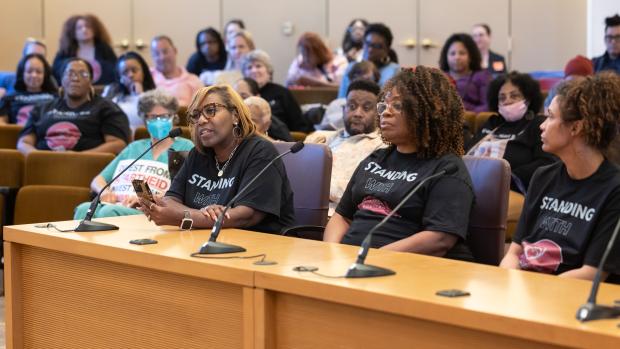OregonMultnomah County
See how Multnomah County performed on our equity assessment of its ARPA Local Fiscal Recovery Fund investment strategy.
Total Equity Focused ARPA Funds
$66,265,262$66,265,262
Overall Score
High
Featured Case Study
Multnomah County, Oregon dedicated $3 million in ARPA funds to the Multnomah Mother’s Trust, a participatory research project that provides $500 in monthly direct cash assistance over 24 months to 100 Black mothers living within the County.

ARPA Equity Assessment of Multnomah County, OR
Overall Equity Focus
 High
HighWas racial and economic equity an explicit focus of the jurisdiction's ARPA investment strategy?
 95% of locations met this criterion.
95% of locations met this criterion. 81% of locations met this criterion.
81% of locations met this criterion. 86% of locations met this criterion.
86% of locations met this criterion.Equity Decision Making Tools and Resources
 High
HighAre equity tools, frameworks, and structures in place to support equitable investment project identification, design, and implementation?
 38% of locations met this criterion.
38% of locations met this criterion.Multnomah County has engaged a set of principles to guide decision-making, including: 1) inclusively leading with race; 2) using an equity and racial justice approach; 3) listening to those closest to the work; 4) embedding a public health approach within priorities; and 5) partnering with jurisdictional partners, community leaders, and community-based organizations.
 24% of locations met this criterion.
24% of locations met this criterion.To better understand which communities were most impacted by the COVID-19 pandemic and to help allocate resources, Oregon State passed a law requiring healthcare providers to collect race, ethnicity, language, and disability information from patients.
 31% of locations met this criterion.
31% of locations met this criterion.The County has developed a reopening framework that evolved from its established equity principles. This framework intends to prioritize the needs of Black, Indigenous, and other communities of color; people over age 65; people who live in congregate settings; and those with underlying health conditions.
 51% of locations met this criterion.
51% of locations met this criterion.Multnomah County has an Office of Diversity and Equity that aims to ensure access, equity, and inclusion throughout the County’s services, policies, practices, and procedures.
 31% of locations met this criterion.
31% of locations met this criterion.The County employed an Equity and Empowerment Lens as a tool to guide planning, decision making, and resource allocation to prompt more racially equitable policies and programs.
 48% of locations met this criterion.
48% of locations met this criterion. 72% of locations met this criterion.
72% of locations met this criterion. 38% of locations met this criterion.
38% of locations met this criterion.Community Engagement
 High
HighDid the jurisdiction engage community members in decision making about the ARPA funds, conduct targeted outreach to historically excluded communities, and implement strategies to reach underserved communities?
 94% of locations met this criterion.
94% of locations met this criterion. 64% of locations met this criterion.
64% of locations met this criterion. 54% of locations met this criterion.
54% of locations met this criterion.Equitable Labor Practices
 Low
LowDoes the jurisdiction use best practices for ensuring public investments deliver family-supporting jobs to residents who have faced barriers to good jobs and economic prosperity?
 36% of locations met this criterion.
36% of locations met this criterion. 16% of locations met this criterion.
16% of locations met this criterion. 70% of locations met this criterion.
70% of locations met this criterion. 29% of locations met this criterion.
29% of locations met this criterion. 11% of locations met this criterion.
11% of locations met this criterion.Equity Investments
 Middle
MiddleDid the jurisdiction make investments that have the potential to advance equity by targeting the communities most harmed by the pandemic and addressing systemic inequities?
 62% of locations met this criterion.
62% of locations met this criterion. 71% of locations met this criterion.
71% of locations met this criterion. 64% of locations met this criterion.
64% of locations met this criterion. 82% of locations met this criterion.
82% of locations met this criterion. 63% of locations met this criterion.
63% of locations met this criterion. 81% of locations met this criterion.
81% of locations met this criterion. 45% of locations met this criterion.
45% of locations met this criterion. 33% of locations met this criterion.
33% of locations met this criterion. 32% of locations met this criterion.
32% of locations met this criterion. 64% of locations met this criterion.
64% of locations met this criterion. 64% of locations met this criterion.
64% of locations met this criterion. 31% of locations met this criterion.
31% of locations met this criterion. 67% of locations met this criterion.
67% of locations met this criterion. 56% of locations met this criterion.
56% of locations met this criterion. 50% of locations met this criterion.
50% of locations met this criterion.Transparency & Accountability
 High
HighDoes the jurisdiction set performance goals, collect data to monitor progress toward equitable outcomes, and provide the public with information about how funds are being used?
 55% of locations met this criterion.
55% of locations met this criterion. 70% of locations met this criterion.
70% of locations met this criterion. 64% of locations met this criterion.
64% of locations met this criterion. 75% of locations met this criterion.
75% of locations met this criterion.